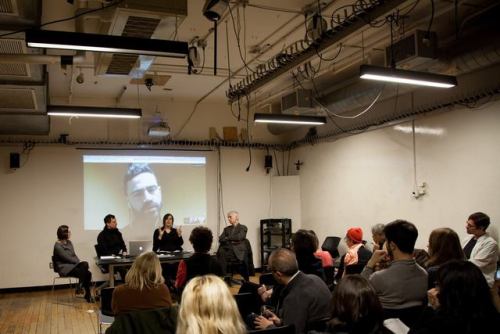#kate sicchio
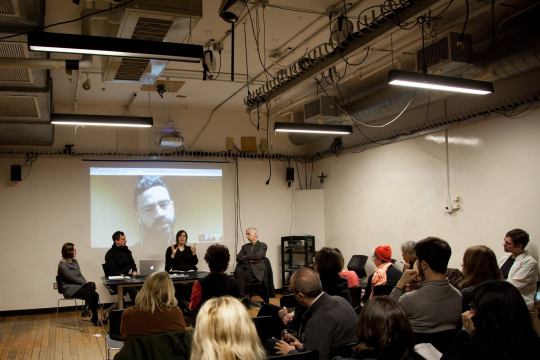
“Now, more than ever, we need to get together to explore ways in which the live media can be used to foster action, creativity, and inclusivity!” - REFEST 2.0 / Presented by ITP, CultureHub, and WITNESS at ITP/NYU - 721 Broadway 4th Floor
The State of Telematic Art in 2017 - A Panel Discussion (Billy Clark, Michael Dessen, Daniel Pinheiro, Jesse Ricke, Robert Rowe, Kate Sicchio, & Sarah Weaver)
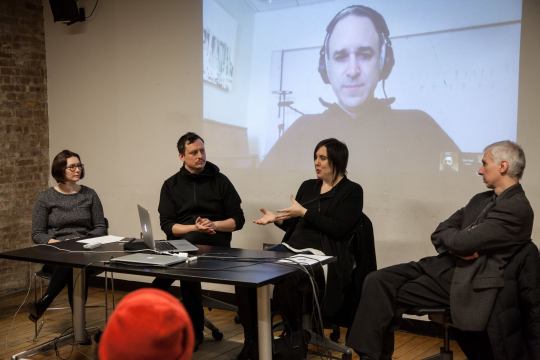
Check out photos of Refest 2.0 here!
Some thoughts on The State of Telematic Art:
From the early experiments on satellite connections to allow the bringing together of distant remote locations into one same (shared) space until nowadays seamless use of online tools that almost invisibly bring together users from any location into the same room, Telematic Art has been exploring the way technology – and more specifically networked environments – shapes human interaction.
The possibility of dissipating time and distance in projects from artists like Kit Galloway, Paul Sermon or in the thoughts of Roy Ascott has been a major concern towards the development of ‘structures’ that often reflect upon the human impossibility of ubiquity.
In projects like LAND PROJECT or, within that one, the more recent, in collaboration with Annie Abrahams, Distant Feeling(s) the main goal is to deconstruct the sense of co-presence in the same time and space and traduce it / materialize it into actions that are (possible) models of re-thinking our agency in a networked society and within the digital sphere.
Either by experimenting ‘moving’ together with someone that is not in the same space as you, but that becomes present through mediation or trying to perceive the presence of ‘others’ in the network by creating a moment of silence and stillness where we’re left alone in front of our computers but as a group, the art object becomes complete in the intersection space; often the output (the format in which the result is shown) – the same surface used for the process of mediation to happen.
Although networked practices find at its core, with the developments made over the last decade on having the tools more accessible to the practitioners, the possibility of building connections between artistic communities and bringing them together in a more sustainable way providing a medium that beyond allowing connection facilitate collaboration, these practices deal with characteristics of the environment in which they happen and elaborate on ways to approach them and shape the methologies of artistic production. The perception of synchronicity in projects like the one’s of Sarah Weaver is one of the many aspects included in the way our body and brain perceive this context which is a specific space for which a specific type of art is being developed.
Thinking about the space where Telematic Art happens is to re-think a space/place and developing tools that widen the potential of the practices related to it. Either it is by connecting human-to-human through the machines, input external live data that disrupts the ‘normal’ (organic) way of moving and/or behaving or, as an example, investigate latency as part of music composing where sounds travel across distant locations and how all of this is (also) a consequence of living in the digital age, transforms telematics into a process of thinking the world we live, acknowledging that we are not constricted to our own contexts but that we can (more easily) reach out and build significant discourses about possible futures – an extension of what we are now.
To be thinking and practicing Telematic Art was and it is about reformulating the present by overcoming (and troubleshooting) impossibilities allowing our perception about the world to change.
Youngblood reiterates the ethical responsibility of artists to utilize telecommunications in a socially constructive manner, but is skeptical of how early telematic artworks merely repeated what had become common commercial practices. “A communications revolution is not about technology; it’s about possible relations among people,” he observes, arguing that this revolution has the potential to invert extant social relations, transforming the centralized, hierarchical structure of geographically discrete nations into one of decentralized, but politically significant, communities defined by “consciousness, ideology and desire.” (…) the artistic use of telecommunications is “special” (i.e., art as opposed to nonart) only if the media are employed in a way that is not “done every day in business and industry,” and therefore “given, obvious, routine, … [and] politicized.”-‘Roy Ascott, Telematic Embrace - Visionary Theories of Art, Technology, and Consciousness’
“Now, more than ever, we need to get together to explore ways in which the live media can be used to foster action, creativity, and inclusivity!” - REFEST 2.0 / Presented by ITP, CultureHub, and WITNESS at ITP/NYU - 721 Broadway 4th Floor | March 5th, 2017
The State of Telematic Art in 2017
A Panel Discussion (Billy Clark, Michael Dessen, Daniel Pinheiro, Jesse Ricke, Robert Rowe, Kate Sicchio, & Sarah Weaver)
Check out photos of Refest 2.0 here!
Some thoughts on this here
Post link

Day 1 and 2: After getting to know the work of all artists involved and the research projects of Motion Bank, we devised questions around ways to incorporate networked interaction for intersection between dance and webrtc technology. We looked into researching tools and different kinds of configuration for networked collaboration and performances. One idea that come up was to find ways to erase the line that splits the screen/space for a more dynamic interaction and approach. Here, we thought to provide users with features that can enhance the experience in a collaborative format while still maintaining the idea of performance as being a product of the process,that is, through the trajectory of creating, documenting and viewing.
Day 3: Daniel and I began our research by looking at possible inputs and outputs that any user would like to have available in order to establish a direct line of communication with other performing and creative technical artists whom are collaborating at a distance.
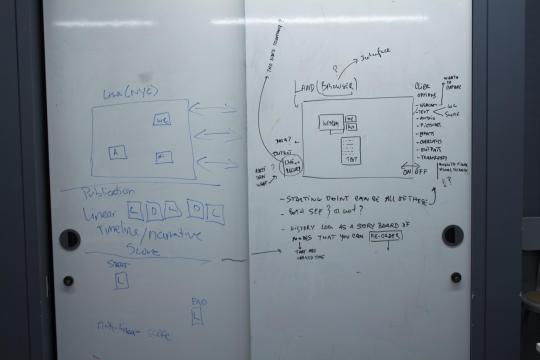
Our first exploration involved visual outputs as a representative documentation of the interaction. Olivia Jack created a webrtc slit-scan program: http://ojack.github.io/slit-scan/
The program records two users/performers moving together and outputs a visually abstract recording that fragments time in various increments (real time, slow and reverse) for the duration of the performance. The speed can be controlled by the each user.
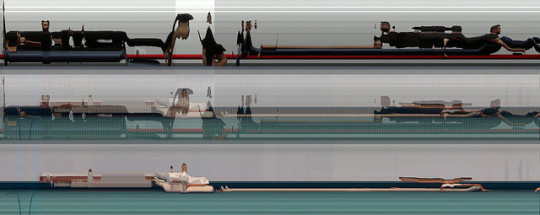
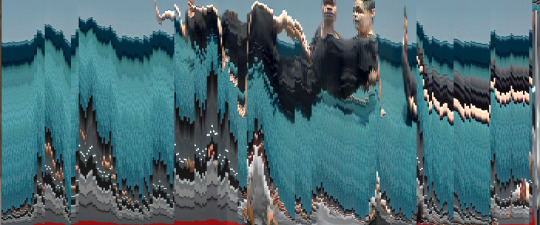
After exploring the slit-scan outcome, we realized that this program could be useful as a type of final representation of a networked performance, or movement experience. However, we thought to explore more the idea of blurring the online spaces to create a more physical/embodied interaction.
Olivia Jack then created a webrtc program called Portals: http://ojack.github.io/portals/
The program allowed us to “move together” allowing for more creating input by each user
Here Olivia (Bogotá), Lisa and Daniel (NYC) experimented moving together using Portals:
Another exploration, this time playing with light and movement (Oliva, Lisa and Daniel):
Day 4/5: In the final days and preparation for our showing, we took our experimentations of using the webrtc slit scan and portals to understand how the networked environments can be reconfigured and adapted to include more bodies, and to include an audio score to direct performers.
We collaborated with Kate Sicchio* to include her project, which involved 10 audio scores. The scores were triggered by data received from solar wind. The data is updated every minute triggering various verbal scores. The dancer/performer moves according to which scores is being dictated from the real time solar wind data.
For the final presentation we used Kate’s audio scores for performers in Bogotá (Colombia), New York (USA) and Porto (Portugal) to make a network dance/performance.
Notes/Reflection:
Here are some thoughts and reflections that arose from the experiences held while participating with LAND PROJECT at the CCL 4. Our group included Lisa Parra Daniel Pinheiro and Olivia Jack. During this time we experimented with three webrtc programs: opentok, slit scan and portal. We then shared our process with others in the group to extend our discoveries and online practice to a community of dancers and programmers to play with and explore.
Two outcomes from CCL 4:
1. Create different visual output possibilities for a networked embodiment experiences for documentation and archiving.
2. Develop a layout for communication and interaction between remote locations for collaboration and performance.
Both of these outcomes included our originally research for this project. In the last year we began using an open-source (webrtc) based platform called opentok. Opentok became ‘meeting point’ for artists to use as online space– open atelier or rehearsal space. We then introduced different inputs and outputs to visually generate and combine material that is automatically recorded and archived as it happens giving more choices to artists for possible post comments and documentation.
Although LAND PROJECT is a relationship between two distinct artists, we are interested in exploring ways to materialize our process and methodologies as a model for others to 'interact’ and share in the process itself.
Opening the process to others and combining it with the work of Olivia Jack and Kate Sicchio was definitely an important step towards an understanding of the use of these tools as a model for artistic practices. The embodiment of the other in the case of LAND PROJECT happens when the communication is established. The screen is definitely a barrier to overcome, like many other barriers that separate people. However, here the communication layout created brought many people together to interact and dance with each other. The participants, in this case, did not need to look at one another in order to feel each other’s presence. In this performance there were four location: in New York, the “green hallway” an open space that began with two performers, but throughout the performance had various people join the two original dancers; another more intimate spaces in New York was the ‘audio room’ where two males performed the scores. Other locations included performers from Portugal and Colombia. In these locations, the performers participated from a living room in one and a bedroom in the other. Language also played an important role, as not all participants understood English very well. All four locations created a performative situation linked together by sound and the internet. Here, the understanding of time and environment is where both the participant and spectators can witness the different locations and draw a multilayered narrative where ‘users’ become spectators of themselves even though they’re interacting with a group of people distributed across different time-zones and spaces.
The participation of Daniel Pinheiro in this edition of the CCL was made possible with the support of The Luso-American Development Foundation.

